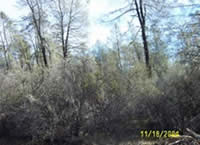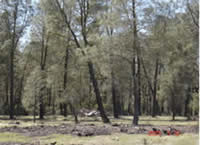
National Fire Plan Success Story
Gravelly Valley Fuels Reduction Project
Upper Lake Ranger District, Mendocino National Forest
National Fire Plan - Fuels Reduction
2007
The Gravelly Valley project is in the Lake Pillsbury area on the Upper Lake Ranger District of the Mendocino National Forest. The project consists of fuels treatments and tule elk and deer habitat/forage improvement. It is an integrated project involving fuels and wildlife management. Much of the project area was overgrown with decadent brush, which was of limited value as wildlife habitat, and the area was in need of hazardous fuels reductions.
A majority of the dense buck brush being treated is approximately 8 to 12 feet high mixed with manzanita 12 to 15 feet high. There are also grey pines and oaks scattered throughout the area. Also in the Pillsbury area are the rural communities of the Lake Pillsbury Ranch and Pillsbury Homesites, both of which are highly prone to wildland fire threats. The Gravelly Valley project creates areas of reduced fuel loading and provides safer and more effective points of control for fire suppression personnel in case of a wildland fire. The reduced fuel loading would also potentially help slow a fire once it burns into a treatment area, allowing for fire suppression crews to more effectively suppress it. In untreated 12 to 15 feet high brush flame lengths can potentially be 30 feet, exceeding safe fire suppression abilities.

Before treatment.

After treatment.
Recent project activities include dozer removal (with rake and/or brush) and dozer piling of decadent brush within a 600 acre area determined by the Forest Biologist and Fuels Officer for maximum benefit of both fuels reduction and habitat improvement combined. Removal of burn piles is accomplished through prescribed burning (with drip torches). The multi-year project has been funded by the Rocky Mountain Elk Foundation, California Deer Association, Lake County RAC, California Department of Fish and Game, Forest Hazardous Fuels Reduction and Forest Wildlife accounts.
Since the start of the project in 2005, approximately 350 acres of grass and brush have been treated. In 2006 and 2007 additional acres were funded allowing the project to continue into 2008. With the current funding the project is estimated to be complete by December of 2008. Accomplishments for 2007 are approximately 100 acres so far with approximately 75 more acres planned. Upon completion of the project, much needed hazardous fuels reductions would be accomplished and the additional acres of improved habitat/forage areas will provide for better survival and healthier herds of the tule elk and deer utilizing the area. Past treatments have shown a positive response especially from the tule elk that are often seen inhabiting the treated areas.
Contact
Lee Morgan - Forest Fisheries Biologist
Phone: (530) 934-1151
E-mail: lmorgan@fs.fed.us
Terry Nickerson - Fuels Specialist
Phone: (707)-275-1440
E-mail: tnickerson@fs.fed.us